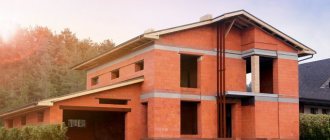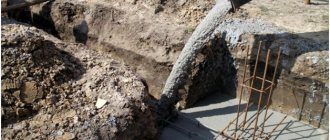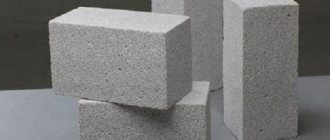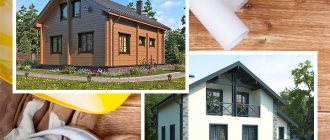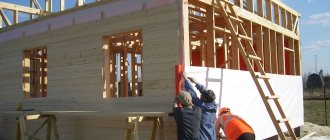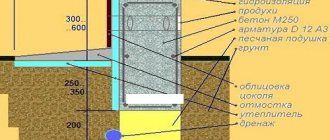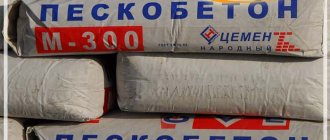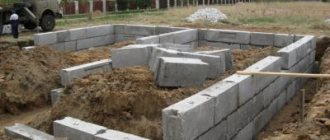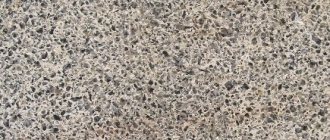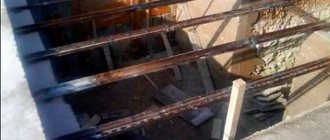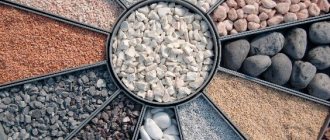Home |Blocks and floors |Aerated concrete or foam concrete, which is better to choose?
Date: October 15, 2018
Comments: 0
Before you start building your own home, determine what it will be built from. The comfort and durability of the home depends on the correct choice of material. Walls made of high-quality composition will retain the heat of the room, prevent the penetration of extraneous noise, and ensure fire safety and environmental friendliness of the building. Today, cellular composites are popular because they have high strength and low weight. The developer has to think about a serious question: which block is better, aerated concrete or foam concrete?
Despite the apparent simplicity of the choice, it is difficult to answer this question unambiguously. The superficial impression is that there is no difference and the materials from which both products are made are similar. After all, each of them inside the array has closed cavities up to 5 millimeters in size, occupying no more than 3/4 of the volume. They differ in the way air cells are formed. Let's take a closer look, compare, consider production, and compare the properties of the products.
The pores of the aerated concrete block even protrude onto its surface
Which aerated concrete is best for home
We believe that the most appropriate gas block for a private home is a high-quality autoclave D400 (375 mm) with a strength of B2.5, and there are four reasons for this:
- Strength is enough for 2 floors.
- Does not require additional insulation.
- This type of masonry is done in one block per row.
- The weight of such blocks (25-30 kg) makes it absolutely comfortable to work on your own.
The best polystyrene concrete blocks
This type of building blocks contains cement as a binder and coarse crushed stone with sand to fill and strengthen the structure.
Polymer additives provide low thermal conductivity and high sound insulation, so the material is often used to insulate existing and newly built buildings.
POLYSTYRENE CONCRETE D250 595Х120/185; 240/375Х295 - for insulation of all types of low-rise buildings
These are the best polystyrene concrete blocks for lining load-bearing walls, because they allow you to increase their thickness by 120 or 240 mm, depending on the chosen option.
The length of the panels is available in two types: 595 and 375 mm, which is convenient when constructing corners and lining window openings in order to make fewer cuts.
The material is supplied on pallets and costs 2800 rubles per m3. It has a large granular structure with polymer additives for reliable insulation.
Pros:
- the strength of the M250 composition can withstand static loads well;
- low density from 150 to 600 kg/m3 ensures low weight and ease of handling when handling blocks;
- one of the lowest thermal conductivity coefficients 0.055-0.14 W/(m*C);
- the asexual structure absorbs less solution;
- high rates of sound insulation;
- allowed for use in buildings up to 3 floors;
- can be placed not only on mortar, but also on construction adhesives.
Minuses:
- low strength 0.2-0.3 MPa requires very careful handling during operation;
- cost from 2800 rubles per m3.
Aerated concrete D500
Now regarding the D500 blocks. Although they are more durable, to achieve the required thermal properties, a wall thickness of 500 mm is required. There are two options: a block 500 mm thick (weighing 50 kg) or two blocks in a row of 300 and 200 mm, which will greatly complicate the laying. As you understand, blocks weighing 50 kg are almost impossible to lay alone, and such blocks are rarely seen on sale.
What thickness and density of aerated concrete is better?
*Review of the best according to the editors of expertology.ru. About the selection criteria. This material is subjective in nature, does not constitute advertising and does not serve as a purchase guide. Before purchasing, consultation with a specialist is required.
Aerated concrete blocks have become a very popular building material in recent years. Russian consumers appreciated its high performance properties, saving time and money during construction. The scope of aerated concrete continues to expand, and demand is pushing manufacturers to expand their range. Today there is a variety of these products on the domestic market, which makes it difficult for an inexperienced buyer to choose. Advice from our experts will help you understand the basic parameters of aerated concrete blocks.
Which is better, aerated concrete or foam concrete?
Since aerated concrete is not the only building material with a cellular structure, it is worth understanding its advantages and disadvantages compared to other similar blocks. We present them in a comparative table of the pros and cons of aerated concrete and foam blocks.
| TYPE OF POROUS MATERIAL | ADVANTAGES | FLAWS |
| AERED CONCRETE | + INCREASED STRENGTH + BEST THERMAL INSULATION + PACKAGING PROTECTS FROM MOISTURE + INCREASED DIMENSIONAL ACCURACY + COMPARATIVELY LIGHT WEIGHT | - HIGH PRICE |
| FOAM CONCRETE | + AFFORDABLE PRICE | — MAY SHRINK — MASONRY ONLY ON SOLUTION — LOW DIMENSIONAL ACCURACY |
Since foam concrete is not treated with steam, its strength is lower. Foam blocks also freeze faster due to the penetration of water vapor into the brick structure. Therefore, for building a house it is better to give preference to aerated concrete, but which manufacturer’s products should you choose?
How to choose an aerated concrete block
- Production technology
. To make aerated concrete, natural materials such as sand, cement, lime, and gypsum are required. Gas formation occurs due to the addition of aluminum dust, which begins to react when water is added with cement and lime. But to harden the mass, manufacturers use two methods. - Autoclave technology
involves processing the formed block with saturated steam, which is supplied at high pressure. This type of aerated concrete is highly durable, but is more expensive. It is recommended for the construction of walls. - Non-autoclave technology
consists of heat treatment of the semi-finished product, sometimes drying occurs in the open air. Aerated concrete is cheaper, but it should be used for constructing partitions. - Brand of aerated concrete
. The defining characteristic of aerated concrete blocks is density. It changes in kg/cubic meter. m, and the numerical expression becomes the brand designation after the letter D. The density range ranges from D200 to D1200. The heaviest blocks are used for constructing load-bearing structures of high-rise buildings, grade D500. D600 is optimally suited for private housing construction. And the most porous and lightweight products (D200. D350) are used for thermal insulation of buildings or creating internal partitions. - Compressive strength
. The density of aerated concrete directly affects another important parameter called compressive strength. For designation it is customary to use the corresponding coefficient in MPa. For example, the popular B2.5 block has a compressive strength of 2.5 MPa, and its density is in the range of 700-800 kg/cubic. m. For comparison, for brick this figure reaches 15-20 MPa, therefore aerated concrete blocks are not used for multi-story construction. - Frost resistance
. The most important indicator of aerated concrete for the harsh climatic conditions of Russia is frost resistance. It is determined by the number of freezing and thawing cycles that the material can withstand without deteriorating performance characteristics. The frost resistance range ranges from F15. F100. Builders recommend using blocks with frost resistance above F50 for the construction of external walls. - Types of gas blocks
. There are several varieties available on the domestic market, differing in shape and size. Rectangular structures are considered classics of the genre; experts distinguish several types in this group. - Masonry or wall aerated concrete blocks
are produced for the construction of load-bearing walls. Sometimes they are also used to construct partitions. With a standard height (200 mm) and length (600 mm), they differ in width (200.500 mm). - Special blocks
for partitions with the same length and height parameters have a width of 75.150 mm. - To create jumpers, you can find on sale blocks 500 mm long, 200 mm high and 250.400 mm wide.
The best foam blocks
Such materials are used to create load-bearing walls due to their high strength and low vapor permeability.
The block has clear, even shapes and a finely porous structure due to the presence of hardened foam in the composition, which provides light weight and thermal insulation. You can drill into walls without special attachments, which makes subsequent installation and wiring easier.
AeroStone D500 (white) 1 Grade - for quick construction of a cottage
This is the best foam block for construction at an accelerated pace due to its length of 625 mm. The buyer has the opportunity to choose the height of the element between 200 and 250 mm, depending on the required dimensions of the structure.
The width of the blocks is 100/150/200/375/400 mm, which allows you to create both thin external extensions and massive load-bearing supports. The strength of the M500 material can withstand high loads, both static and mechanical.
How does the brand affect the aerated concrete block?
- Strength and density. The higher the density of the aerated block, the stronger it is, and therefore the colder. The brand number corresponds to the density of the block. For example, brand D400 means that the density of the aerated concrete block is 400 kg/m3 and so on.
- Fire resistance. Aerated blocks of any brand are fire-resistant and can withstand high temperatures for more than one hour.
- Thermal conductivity. Gas blocks with a lower grade are characterized by better heat retention.
Recommendations when choosing a gas block
Autoclave blocks are stronger than non-autoclave blocks, so it is more rational to use them for building houses.
- The surface of the aerated block should be as smooth and even as possible. A high-quality gas block is symmetrical and of regular shape. Sometimes recesses are allowed for ease of transportation.
- The gas block should have a light gray tint; the presence of stains, cracks, and chips is unacceptable.
- Do not forget that with higher strength, heat and sound insulation decreases. Therefore, the choice of gas blocks depends on your preferences and priorities.
- Aerated blocks must be well packaged; passports and product certificates must be attached to each batch. Don’t be lazy to ask the customer about them, the durability of aerated blocks depends on this.
Why do aerated concrete blocks crack over time? The fact is that often unscrupulous builders violate technology, saving money. Aerated concrete should be laid exclusively with special glue, and we must also not forget about the reinforcement of the masonry.
Composition and production technology
Aerated concrete is made from a raw material mixture, which includes:
- Portland cement grades M400 or M-500, without active mineral additives.
- Quicklime calcium lime, which contains at least 70% calcium oxide (Ca2O).
- Quartz river sand with a SiO2 content of at least 85%.
- Water.
- Aluminum gas former (in paste form). The content of active aluminum is at least 80%.
The gas block production technology consists of several stages:
- Preparation of components.
- Preparation of raw material mixture. The aluminum gas former should be added last.
- Molding of gas block arrays.
- Cutting the mass into separate blocks.
- Autoclave processing.
- Packaging of products and transportation to the warehouse to gain strength.
If you follow this technology, the aerated concrete will be of high quality.
Top 10 manufacturers of gas blocks
- XELLA is a German construction company that is famous for producing the best aerated blocks of the highest quality. This is a fairly young organization, however, due to the use of the latest construction technologies and materials, XELLA gas blocks are popular not only in Germany, but throughout the world.
- EuroAeroBeton is a Russian manufacturer that produced the first aerated block only 10 years ago. The plant of the enterprise is located in the Leningrad region, the city of Slantsy. The company operates using German technologies and using German equipment.
- Voronezh Construction Materials Plant is a leader in the Voronezh region, as well as nearby regions. The company has a long history and has been producing building materials for 55 years. High-quality, durable products are the key to the work of experienced employees.
- LSR.Construction-Ural is a leader among local enterprises. The plant, with a 50-year history, operates on German equipment, resulting in high-quality and durable products.
- The Kazan silicate wall materials plant is an enterprise that produces building materials in huge volumes. The plant provides materials to Tatarstan, as well as the Volga region. The company has been producing aerated blocks for 14 years, using the experience of specialists as a basis.
- Lipetsk silicate plant is one of the leading enterprises in Russia. The plant supplies products to Moscow, Tula, Tambov and other regions. The enterprise is equipped with advanced technologies and meets international quality standards.
- Glavnovosibirskstroy is a large Siberian enterprise that works closely with German construction companies.
- The Perm Silicate Panel Plant is a construction complex that provides housing for military personnel. The plant occupies a leading position in its field and carries out the design of most local projects.
- Saratov Building Materials Plant is one of the best enterprises in the construction industry. The company is famous for its high quality of work, the use of advanced construction technologies, and competent employees.
- The Kostroma silicate plant is the oldest enterprise in Russia. Over decades of work, the plant has developed a clear plan, which has been bearing fruit for 50 years. The company grows every year and provides products not only to its native land, but also to other regions.
When purchasing aerated blocks, you need to carefully read the quality certificates; do not buy building materials from unknown companies. This is fraught with the appearance of cracks and chips. We hope the above rating of gas blocks and recommendations will help you in choosing quality blocks.
